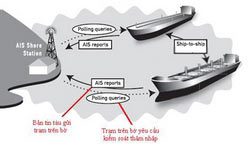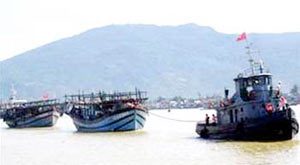Recently, some reports indicated that Chinese vessels escaped disaster thanks to the Automatic Identification System (AIS). However, this is not a device typically used by fishing boats…
When Typhoon Chanchu unexpectedly changed direction, it caused damage to Vietnamese fishing boats that were unable to call for help in time. In contrast, Chinese vessels escaped the storm thanks to notifications about wind speed and the typhoon’s path sent by local maritime safety authorities via the AIS system.
 |
|
Operation diagram of the Automatic Identification System (AIS) |
Information was transmitted to Chinese and foreign vessels in the storm-prone area, providing guidance for ships seeking shelter. So, what types of vessels did the Chinese use to escape Typhoon Chanchu? And why did Vietnamese fishing boats not utilize this equipment?
A specialist from a specialized electronics company based in Hoan Kiem District, Hanoi, stated that AIS is not a new device. AIS has been around for about 3-4 years, but in Vietnam, it is only used for deep-sea vessels and large cargo ships.
Mr. Nguyen Duc Toan, Director of the Maritime Equipment Joint Stock Company, located at 46 Hang Dau, Hoan Kiem District, Hanoi, mentioned that fishermen are very poor. Usually, they only use common and affordable equipment such as Galaxy or Wenden 4.800 walkie-talkies.
These walkie-talkies can communicate over distances of 170 to 180 kilometers and cost nearly 3 million VND per set. Additionally, when fishing boats venture further offshore, they commonly use ICOM 718 or STEM S.600 devices with 100W power, providing communication ranges of 1,000 to 1,500 kilometers. The price of these two types is nearly 9 million VND per set.
|
What is AIS? The Automatic Identification System (AIS) is a communication information system that allows ships to exchange information regarding their identity, position, direction, and speed with each other or with shore stations. This system has been established as an international standard for the maritime industry and is mandatory for certain types of vessels like deep-sea ships and large cargo ships (over 300 tons), as well as passenger vessels. When using this system, ships within communication range can exchange information about their identity, direction, and speed to avoid collisions. Additionally, vessels can share other necessary information such as assistance during incidents, weather information, etc. The AIS system consists of a radio transceiver (including a VHF transmitter and two VHF receivers) and a control and display unit. Furthermore, each station on the ship can communicate with other devices like onboard sensors, output interfaces such as ECDIS, ARPA, VDR, or Inmarsat satellite terminals. Additionally, when combined with other communication devices, AIS can be used in emergency situations, rescue, and salvage operations at sea… |
When asked about the AIS system, Mr. Toan stated that China only uses this equipment for cargo ships, not for fishing vessels. In Vietnam, cargo ships going abroad also utilize this type of equipment.
AIS is not a storm avoidance system. It is merely a collision avoidance alert system that warns when a ship is approaching another vessel or when there is an obstacle within the ship’s proximity. In such cases, this device activates by sending out a signal to prevent collisions.
The cost of this equipment is relatively high. Some AIS devices produced in South Korea cost around 50 million VND, while those from Japan are priced at over 60 million VND. Due to the high costs, fishermen find it difficult to equip their fishing boats with such devices.
Currently, there is a maritime information device called Lavpex, which may be beneficial for fishermen. This device costs around 14 to 15 million VND. It is capable of receiving global information about hazardous weather conditions in areas where ships are traveling. When a ship enters a specific area, it automatically collects information from regional stations. However, the inconvenience is that this device operates in English, which most Vietnamese fishermen are not proficient in.
Additionally, there is an orange smoke signal flare used to signal distress when a ship is in trouble, but this is also only used for cargo vessels, not fishing boats.
Meanwhile, according to Mr. Pham Ngoc Quang, a member of the Flood and Storm Control and Search and Rescue Steering Committee (Ministry of Fisheries), recently, Vietnamese fishing boats have been using ICOM communication systems.
Most offshore fishing vessels are required to install this ICOM communication device.
Compared to other devices, ICOM is relatively modern with radio transmission and a longer signal reception range. Moreover, the ICOM device is more sensitive and effective.
Mr. Quang stated that fishermen should have more modern devices such as Global Positioning System (GPS) devices. However, these devices are very expensive, making them hard for fishermen to afford.
According to Mr. Quang, under current regulations, offshore fishing vessels must be equipped with safety equipment such as life buoys, liferafts, life vests, and safety gear to prevent flooding and fire, including specified types of lights according to maritime standards.
 |
|
Vietnamese Navy ships continue to join rescue and salvage efforts with those from China and Taiwan to search for missing fishermen. Photo: HC/VNN. |
Ships must be fully equipped with safety equipment that meets technical and human safety requirements for their specific types before they can be registered, certified for technical safety for sea voyages, and assigned a vessel number.
So, did Vietnamese fishing boats that set sail during Typhoon Chanchu have all the necessary equipment? This question also raises concerns for regulators…
Additionally, another question arises: under what conditions did Chinese vessels escape disaster… Meanwhile, as we know, AIS is not an appropriate system for fishing vessels. So, what type of vessels did Chinese ships use to escape, and what allowed Chinese fishermen’s boats to avoid disaster?
Ngoc Huyen

















































